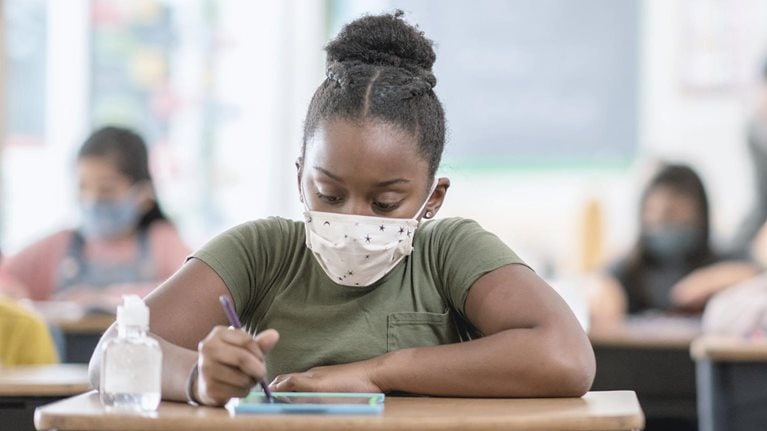Most K–12 students in the United States have returned to the classroom and to a semblance of a normal learning environment. Yet they continue to battle challenges related to the pandemic. Our analysis shows that nationwide, an estimated 17 million students have more than half a year of pandemic-related learning delay, 16 million students who need mental-health support are not receiving it, and 15 million students are chronically absent.1 These challenges are interconnected and mutually reinforcing: students who are not in a mental state conducive to learning or are simply not present in school cannot participate in learning recovery interventions. Therefore, the three challenges should likely be tackled together—and soon.
At the same time, districts are under extraordinary pressure—pressure to deliver results for students, many of whom have missed significant learning milestones, and pressure to do so with limited (and potentially diminishing) funds, with the Elementary and Secondary School Emergency Relief Fund (ESSER) funding window closing by September 2024. As districts look hard at their budgets, they need to understand how to prioritize investments in proven interventions to address the interconnected challenges students are facing.
Below, we outline these three challenges, examples of bright spots for each, and what it might take for states, districts, and philanthropies to scale interventions to reach a greater proportion of students in need (see sidebar, “Looking beyond ESSER to fund interventions”).
Prevailing student challenges and bright spots
Learning delays, diminished mental health, and absenteeism present real challenges for today’s students. Schools have an opportunity to address them by applying lessons learned from existing bright spots.
Learning delays
More than 17 million students nationwide have experienced more than half a year of pandemic-related learning delay (Exhibit 1).2 Without interventions to support their recovery, each student could lose an estimated $54,000 to $69,000 in lifetime earnings.3

The bright spots. Several states and districts have seen accelerated rates of learning recovery after adopting high-quality instructional materials (HQIM) and aligned professional development; providing high-quality, high-intensity tutoring4; and extending the school year through summer or intensive-learning academies.
HQIM paired with high-quality aligned professional development have demonstrated effectiveness in raising students’ state assessment scores. And given that HQIM are comparable in cost with low-efficacy materials (excluding the cost of switching), they are budget neutral. Nebraska and Louisiana saw significant improvements in their students’ math and reading scores after adopting high-quality curriculums. Nebraska used ESSER II funding to provide free access to Zearn Math, a digital learning platform, for all public and nonpublic elementary and middle schools.5 More than 9,000 educators in nearly 500 schools in Nebraska used Zearn Math in the 2020–21 and 2021–22 academic years. Students who used it consistently saw their math scores increase at up to 2.5 times the rate of students who did not.6 Louisiana, after using a portion of its ESSER funding to invest in HQIM in the way of literacy screeners and science of reading curriculums, saw an increase of more than two points in fourth-grade National Assessment of Educational Progress reading scores in 2022 compared with 2019 (in contrast to a three-point decline in national fourth-grade reading scores between 2019 and 2022). The state anticipates an increase of more than ten points by 2027.7
Meanwhile, districts across Tennessee and the Saint Paul Public Schools in Minnesota are seeing noticeable student academic gains as a result of high-quality tutoring. The State of Tennessee is addressing shortages of qualified tutors by releasing playbooks to help districts partner with community organizations to launch tutoring programs and provide tutors with training.8 About 50,000 Tennessee students participated in tutoring programs in the first year, resulting in one-third of a year of academic growth on average among students in kindergarten through second grade.9 Saint Paul Public Schools budgeted $1.8 million toward the WINN (What I Need Now) program, which pairs struggling elementary school students with top reading teachers. On average, third-grade WINN students have experienced a 60 percent increase in state assessment scores, compared with a 40 percent increase among nonparticipants.10
While we are still waiting on quantifiable postpandemic results from summer and intensive-learning academies, prepandemic efforts showed positive outcomes. For example, before the pandemic, Lawrence Public Schools in Massachusetts launched Acceleration Academies to provide supplemental intensive instruction and tutoring to students during school vacations, pairing struggling students with highly effective teachers in small-group settings (with a student–teacher ratio of approximately ten to one). The program saw a 17 percent increase in median Massachusetts Comprehensive Assessment System math scores over the first three years.11
Mental health
The COVID-19 pandemic exacerbated preexisting mental-health challenges in youth. From 2020 to 2021, 42 percent of high school students reported experiencing persistent feelings of sadness or hopelessness, and 10 percent reported having attempted suicide (compared with 31 percent and 7 percent in 2017, respectively).12 Currently, an estimated 17.4 million K–12 students have mental-health needs, but only 1.1 million students could be served in school based on current mental-health provider capacity.13 This means more than 16 million students with mental-health needs are unserved in schools.14 While data is still emerging about mental-health needs in 2023, anecdotal evidence suggests that there has been limited improvement more than a year after students returned to fully in-person learning.15
The bright spots. Interventions in student mental health exist along a continuum, ranging from preventive supports offered to all students (tier one) to acute interventions offered to the subset of students in greatest need (tier three). Bright spots have emerged across this continuum.
Evidence shows that increasing availability and access to mental-health services and trained professionals helps prevent avoidable mental-health crises. Pulaski County Schools in Kentucky implemented a universal screening tool pilot that identified an additional 16 percent of students who might need support and increased the number of school-based mental-health clinicians available to serve those students.16 And nearly 900 educators in San Antonio, Texas, have received mental-health first aid training to better support and determine student needs.17 Hawaii launched a telehealth effort, ensuring that the approximately 170,000 students in the state’s 295 schools will have free access to virtual one-on-one mental-health counseling services.18
The State of California and Henry County in Georgia have both developed nontraditional mental-health support roles to mitigate the human capital challenge. Through the Wellness Coach Program in California’s broader Children and Youth Behavioral Health Initiative, new or existing associate or bachelor’s degree holders can pair programs of study in education with 400 hours of structured behavioral-health field practicums. This program, which is set to begin in the fall of 2023 with a $360 million investment over five years, has the potential to expand the pipeline for mental-health professionals.19 Henry County has added one mental-health and -wellness facilitator to every school in the district. These individuals can support students’ mental health by teaching techniques for managing anger and anxiety, fostering connectivity, and other actions.20
As the period in which districts can supplement regular budgets with stimulus funding ends, Medicaid reimbursement for school mental-health supports could potentially help expand access. California has recently enacted policies in this vein that will reimburse school-based mental-healthcare costs for students enrolled in the state’s Medi-Cal Managed Care plans.21
Absenteeism
An estimated 15 million students were chronically absent during the 2021–22 school year.22 This means that approximately one in three students is missing at least one day every two weeks, representing a dramatic increase in the incidence of chronic absenteeism: an estimated eight million students were chronically absent from 2018 to 2019. And early evidence shows limited signs of this trend abating.23 Absenteeism can have significant repercussions: research from the Utah Education Policy Center finds that chronically absent students are 1.7 times less likely to meet grade-level standards for reading and 7.4 times more likely to drop out of school.24 According to our analysis, this puts roughly two million students on track to drop out before graduation—nearly double the rate before the pandemic.
The bright spots. While many factors that contribute to absenteeism may be outside schools’ control and results from efforts to curb absenteeism are still emerging, a few practices are showing promise for reengaging students.
Some districts, including Baltimore City and Sacramento City, are exploring more transparent and actionable data practices. Under a shared-data agreement in Baltimore, child welfare workers monitored attendance data and were able to identify 700 children each month for more social services.25 And Sacramento City developed a new system that enabled the district to better track and analyze attendance—and thereby identify students in need of intervention. Chronic absenteeism fell by an average of 2 percent in pilot schools.26
In Louisiana, districts have tackled chronic absenteeism through restorative wraparound practices, such as launching positive-messaging campaigns about attendance and adding staff dedicated to lowering absenteeism starting in summer 2021. Chronic absenteeism in the state went from 28 percent in the 2020–21 school year to 19 percent in the 2021–22 school year, inching closer to the rate of 16 percent seen before the pandemic.27
Increasing engagement with families may also help curb absenteeism. Connecticut lowered chronic absenteeism through home visits and personal engagement with families of students who were chronically absent or at elevated risk of becoming chronically absent, such as those transitioning from middle to high school.28 Fulton County, Georgia, sent thousands of text and mail nudges to families of students who were chronically absent or at-risk of being chronically absent during the 2020–21 school year and estimates that it prevented 8,000 to 18,000 absences across the district of 90,000 students.29
What it might take to scale
Here we focus on scaling bright-spot interventions in learning delay, given that this area currently has the broadest evidence base for the costs and effects of tested solutions. More research is needed to understand the investments necessary to scale mental-health and absenteeism interventions and to understand how to design comprehensive interventions that account for the interactions among learning, absenteeism, and mental health.
Theoretically, absent time and human capital constraints, dedicating the full remaining ESSER funding toward high-quality, high-intensity tutoring could address pandemic-related learning delays for every student with more than nine weeks (a quarter of a year) of learning delay in 42 out of 50 states. However, the reality is that districts are unlikely to be able to hire enough tutors, schedule enough sessions, and administer programs on that scale—and do so within the remaining months of ESSER.
Addressing pandemic-related learning delays in the real world and for as many students as possible will require layering interventions—HQIM, high-intensity tutoring, and summer learning. We consider three potential scenarios for layering interventions.
Scenario 1: Every district in the United States scales existing bright-spot interventions
Scaling existing bright-spot interventions nationally across these three learning interventions could address the pandemic-related learning delay of 57 percent of students within one year and still leave significant ESSER funds on the table (Exhibit 2).30

This would entail implementing HQIM for all students starting in the 2023–24 school year, offering summer learning to all students who need it, and offering high-intensity tutoring to about 8 percent of the K–12 population. However, this approach would not entirely close the learning gap: the remaining 43 percent, or 20.6 million students nationwide, would still have some pandemic-related learning delay.31
Scenario 2: Scale faster than existing bright-spot interventions
Closing the remaining gap within the ESSER budget envelope and timeline would be possible only if districts could roll out more-effective programs at a faster rate than we have seen to date. For example, districts could address the full extent of pandemic-related learning delays if they doubled the effectiveness of existing summer learning (toward what was experienced in highly effective prepandemic vacation acceleration academies) and found the capacity to tutor an additional 13.6 million students. However, given existing district capacity constraints and the tight time frame, this goal would be very challenging to achieve.
Scenario 3: Embed solutions on an ongoing basis
A more realistic and sustainable approach may be to embed practices into future budgets. Extending the recovery period from one year to two, providing an additional year of HQIM and aligned professional development for teachers, could address 83 percent of students with pandemic-related learning delays (Exhibit 3).

While this approach would not reach 100 percent of students, it has the potential to be more sustainable—despite the looming expiration of ESSER funds. Given that districts already include spending for instructional materials within their budgets, they need only bear the incremental cost of switching to HQIM.32 Schools could consider using current staff or community partners to provide tutoring capacity. And given that many districts already offer summer school, they may not need to build entirely new programs but rather could improve upon the existing infrastructure. In general, it will be important to focus on models that can be sustained without significant incremental funding. Districts could also consider replacing less effective interventions and reallocating budgets toward the above solutions.
The challenges facing K–12 students in the aftermath of the COVID-19 pandemic are complex and interrelated. However, there is hope in the emerging bright spots, which range from investments in human capital to innovations in learning and student support models. With layered and scaled interventions, districts could potentially address many of the learning delays attributed to the pandemic and start to narrow persistent learning gaps that predated it.33
Of course, significant barriers are likely to impede the implementation of these solutions. As districts, philanthropies, and private-sector actors work together to approach the theoretical recovery trajectories,34 they would be well advised to understand the full impact of their interventions and the extent to which they address students’ most pressing challenges. This understanding would support districts in embedding effective interventions in their repertoire, helping to close not only the pandemic-induced gaps but also the persistent educational-opportunity gaps that have existed for generations.


